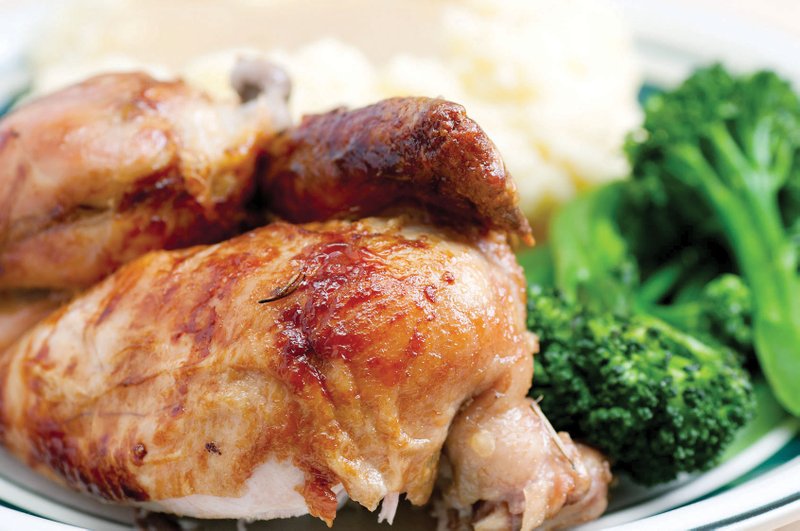It seems to me sometimes that too many people treat recipes like scientific formulas to be followed precisely. But that isn’t how I love to cook, or how I hope fans of my cookbooks or online cooking school will treat my recipes.
Great recipes are living things. Most of them can be changed in an instant, based on what’s in season or good in the market, how ingredients are responding as you cook them, and whatever whim might strike you. That’s certainly how I like to cook, especially at home. And I’ve been thinking about that a lot lately while looking at my recipe for pan-roasted chicken with a sauce of port and whole-grain mustard, and seeing how it has evolved over the years.
When I first started making and serving this recipe more than two decades ago, it featured butterflied chicken — that is a whole bird from which the backbone was cut out before the chicken was spread out and flattened. I browned the chicken skin-down in an ovenproof skillet, finished cooking it skin-up in the oven, and prepared a pan sauce with port wine, cream, two kinds of mustard and fresh herbs.
Today, however, the dish as I make it is noticeably different. First of all, I take the extra step of removing most of the bones from the chicken — a fairly simple process I describe in the recipe that follows, though you could also ask the poultry department of a good supermarket to do it for you. The result is poultry that is easier and neater to eat, which I know the guests in my restaurants prefer.
As for the recipe’s popular sauce, I’ve also made significant changes. Most noticeably, I use a higher proportion of port and chicken stock, reducing them more to intensify the sauce’s overall flavor before I add the two kinds of mustard. More importantly, I also use proportionately less cream than I used to, a reflection of the fact that health-conscious eaters everywhere are trying to cut back on the fat they consume. And, a favorite secret of mine when cooking at home, I stir into the sauce a touch of bottled barbecue sauce or Chinese hoisin sauce, which enhances the results in the same way that glace de viande (literally, “meat glaze”), a greatly concentrated veal stock, often does in classic French restaurants.
All of those small changes add up to a big difference in a recipe that I hope will become one of your own standbys, as it is mine. And I hope you, like I still do, will continue to consider this and many other recipes delicious works in progress.
BONELESS PAN-ROASTED CHICKEN WITH PORT AND WHOLE-GRAIN MUSTARD SAUCE
Serves 4
Ingredients:
2 whole organic chickens, 2 1/2 to 3 pounds each
Kosher salt
Freshly ground black pepper
6 tablespoons extra-virgin olive oil
2 cups port wine
2 cups good-quality canned chicken stock or broth
2 tablespoons bottled tomato-based barbecue sauce or hoisin sauce
4 tablespoons heavy cream
1 heaping teaspoon Dijon mustard
1 heaping teaspoon Meaux (whole-grain) mustard
1 tablespoon chopped fresh tarragon
1 tablespoon chopped fresh Italian parsley
1 tablespoon chopped fresh chives
Directions:
Starting alongside each chicken’s breastbone and following the rib cage, use a sharp knife to cut the meat away from the bones on each side; cut through the leg joints. Trim off the wings, leaving the drumettes attached. Cut out the leg bones to produce 2 boned halves from each chicken.
Preheat the oven to 400 degrees. Season the chicken on both sides with salt and pepper. Over high heat, heat the oil in a heavy ovenproof frying pan large enough to hold the chicken. Carefully add the chicken skin-down. Sear undisturbed until the skin is golden, about 8 minutes.
Transfer to the oven, and roast skin down until the skin is deep golden brown and the chicken is cooked through, 12 to 15 minutes. Return the pan to the stovetop, turn the chicken skin up, and sear over high heat 1 to 2 minutes longer. Transfer the chicken to a platter, and keep warm.
Pour off the fat from the skillet. Add the port, and swirl over high heat, stirring and scraping with a wooden spoon as needed, to deglaze the pan. Add the stock. Simmer briskly until reduced by about two-thirds.
Stir in the barbecue sauce or hoisin. Stir in the cream, bring back to a boil, and continue simmering briskly, stirring, until thick enough to coat the back of a spoon. Season to taste with salt and pepper. Reduce the heat to low, and stir in the mustards.
Return the chicken to the pan along with any juices that have collected. Over low heat, turn the chicken to coat with the sauce and warm it briefly. Serve with your choice of sides, garnishing the chicken with fresh herbs and the port/mustard sauce.
